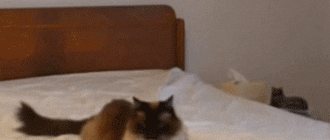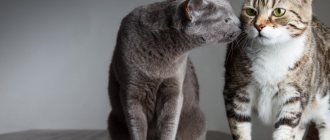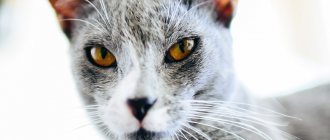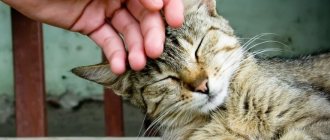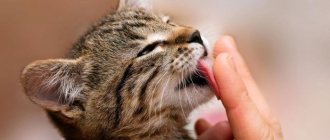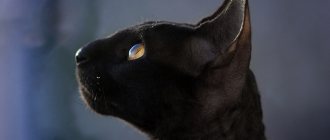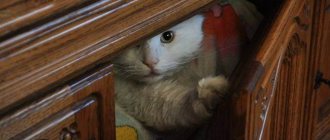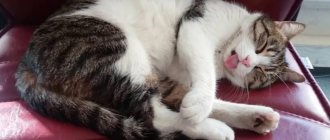How cats talk to people
Science has long been trying to study cats, but they are reluctant to participate in experiments and various types of research. Researchers prove that our four-legged furry creatures came to Europe from Egypt. But there is another version that the domestication of cats occurred in Nubia more than 3 thousand years ago from a North African cat. Only later did they appear in Egypt and Asia.
You can understand a cat's language by observing your pet.
Cats were respected and endowed with superpowers. The ancient Greeks, who brought cats into the country illegally, were immensely grateful to them for their fight against rodents and even made the cat a symbol of the Spartacus uprising. In Egypt, cats were used not only to fight mice and rats, to protect crops, they were trained to hunt birds, hares, and moles. The Egyptians elevated them to the rank of deity, whom they worshiped. Mummies of cats were found in the burials of ancient Egyptians along with the mummies of nobles.
Peaceful cat
In Rus', cats served in Orthodox churches, art galleries, palace chambers, and bazaars. The cost of the first cats brought to Russia was equal to the cost of an ox and amounted to 200 grams of silver. Cats are still in service in the Hermitage. Each of them has their own personal bowl, place to sleep, and veterinary documents.
Important! The only animal that is allowed to enter the temple freely is a cat.
People love their furry pets so much that they even decided to make March 1st World Cat Day. True, it has not been officially approved anywhere, but lovers of their fluffies all over the globe on this day show them all respect, honor and gratitude for their existence, for their fight against rodents.
Sign language: what does the tail, paws, ears, posture mean?
Cats do not speak human language; cat language causes confusion in humans. But if you try and observe our smaller brothers, their facial expressions and behavior, you can learn to understand cat sign language.
Aggression in cats can be caused not only by their dissatisfaction; perhaps they are worried about something, are alarmed, and seek protection from the owner. They cannot draw attention to themselves in any other way, it doesn’t work.
Note! If you look at a cat under a “microscope,” then its body language can say a lot.
The position of an animal's tail can also tell a story. For example, a peacefully resting cat begins to nervously move its tail from side to side when its owner approaches. This suggests that something is bothering him, he is alarmed, nervous. If only the very tip of the tail moves, it means that the anxiety is minor or the pet is falling asleep.
A tail raised to the top tells of the dominance of a given individual over others or shows the alertness of the animal. Sharp swings of the tail from side to side indicate extreme irritability of the pet, its dissatisfaction, and a warning of an attack. In this case, it is better to leave him alone until he calms down.
For your information! Animals can greet each other with their tail raised. A tail hanging down indicates that the pet is hungry, thirsty, or dissatisfied with something.
Cats attract the owner's attention with a soft touch of their paw pads when they are hungry, thirsty, or ask to be petted. They can hug the owner’s arms or legs, grab the edge of clothing, or climb up pants with their claws.
To attract attention, cats go to different lengths
Stomping all over their owner, their claws slightly extended, as if giving a massage, the fluffies succumb to the instinct associated with childhood, when they received their mother's milk by massaging her breasts. That is, there is recognition of a loved one, a feeling of security, safety.
The language of cats in the form of a raised paw tells of concentration, the desire to understand the unknown, caution, and a state of shock. Having dealt with the incomprehensible, the animal dies.
Facial language: smile or grin
The downward whiskers indicate that something is wrong with the kitten, perhaps he is not feeling well, he is dissatisfied with something, or irritated. Licking that is not related to food indicates nausea or thus shows concern or interest in something.
Their muzzle, like a human face, can express a serene mood, satisfaction, or vice versa, fear and aggression. A smile expresses a good mood, and a bared mouth warns of the threat of an attack.
A cat sitting with his tongue hanging out and his mouth slightly open means that he is focused on hunting for a mouse, or he is hot, or he was caught stealing from a table. It looks pretty funny, unless of course it is a disease.
Sad face with drooping mustache
What does attention to the ears mean?
A cat mood phrasebook can be compiled based on the position of the ears. Ears directed forward tell about the pet’s good mood, its peace, calmness, and readiness to make contact. Ears turned in different directions indicate that the animal is worried, does not know how to behave, and is showing interest in something or someone.
But ears pressed to the head or sticking out back warn of impending danger. The pet is alarmed, afraid of something, ready to attack at any moment. By twitching their ears, cats are trying to say that they are nervous, anxious or don’t like being scolded for their offense; they are not inclined to communicate at the moment.
Body poses
Unable to express their emotions in words, cats try to show it through their body postures. Approaching the owner, the fluffy ball shows its affection towards him by dancing its body. He presses himself to the legs, stands on his hind legs, rises and falls, showing his love in every possible way.
The stomach of any animal is the most vulnerable, least protected part of the body. If the cat lies down on its back, exposing its tummy for stroking, it means that it trusts the person immensely, feeling completely safe. He is sure that he will not be harmed or hurt.
Additional Information! If an attempt to stroke the animal’s tummy causes a protest, it means that the cat is simply scratching its back and is not waiting for affection from the outside.
Pose when the pet likes everything
Voice signals
How to understand a cat, what he is trying to say when he meows, can be determined by observing him from the side. By meowing, a cat can notify that it has gone to the litter box, is hungry, asks to be let out into the street or let into the house, simply in this way expresses its emotions. With a hiss, she warns of an attack, expressing her dissatisfaction, fear, and aggression.
Important! A cat finds her kittens to nurse by the vibrating sound they make immediately after birth. This habit of attracting attention when they are hungry continues into adulthood.
Cats purr loudly when demanding food and while eating it. The tonality of the rumbling differs in different cases. The hungry rumbling-meowing of a lost or abandoned kitten resembles the crying of a baby.
Loving mother and kitten
What does friction against the owners mean in cat language?
If a mustachioed pet rubs against the legs, arms or face of the owner, he expresses his declaration of love to him. By touching a person's lips with a wet nose, the animal seems to kiss him and express his gratitude.
There are now many videos on social media apps showing cats talking to their owners. The cat talks like a person, can respond to the inconvenience caused to him, there is a conversation between two cats sharing territory. All these videos can be viewed and are free to download. It turns out that getting them to talk is not as difficult as it seems. A cat can be made to learn a few words or phrases in human language.
If a cat rubs against its owner, it shows its love.
What does a cat want to say with a gentle purr?
Purring shows that the cat is good, comfortable, happy with everything, loves and is loved. But sometimes rumbling can express pain, nervousness, and fear. According to veterinarians, cats purr when they die when they are euthanized.
There is an opinion that the rumbling of an animal helps relieve stress and rejuvenates tissues. The frequency of 25-100 Hz, at which purring occurs, is used in many therapeutic devices in physiotherapy rooms. At a frequency of 25-50 Hz, bones grow together better, and at a frequency of 100 Hz, soft tissues and skin are healed.
What does a cat's screams mean?
When bringing a cat into the house, many expect only a joyful purr from it on their lap. But each animal has its own difficult character. When it has any desires or problems, it can express them with such a loud cry that can be heard several kilometers away.
A pet will not scream for no reason, there is always an explanation for this. Most often, the reason to shout is sex hormones, which begin to act with the onset of spring. The language of cats notifies the circle of his desire to have a cat.
Additional Information ! An unsatisfied cat may demand a cat up to 10 times a year. The cat gets excited every time he feels the female’s sexual secretion.
Failure to satisfy sexual needs negatively affects the physical and mental state of the animal. To satisfy their physiological needs, cats place marks in the apartment, try to escape outside, and howl heart-rendingly. With their screams they try to attract mating partners.
Redistribution of territory
A pet's cry may mean dissatisfaction with changes in his life. This could be moving to a new place of residence, the appearance of a new pet in the family or the loss of an old one, or a change of owner. The animal expresses its dissatisfaction with circumstances, stress from what is happening, and uncertainty about the future by screaming.
Head, paws, torso
To convey important information to others, cats use literally everything! No part of the body is left “overboard”. Take, for example, the head. If a cat butts with it, poking at a person’s legs, it means it attracts attention. In the same case, when two animals touch their foreheads, you can be one hundred percent sure that there is friendship and complete mutual understanding between them.
In the language of cats, a body turned sideways towards another animal or person means readiness for attack or defense. This position can often be seen in a female who is protecting her babies.
© shutterstock
If a cat moves its paws as if trampling, it means that it is happy with everything and is absolutely happy. This gesture is born in childhood. Kittens, sipping mother's milk, seem to massage her belly with their paws. In their language it means boundless love, gratitude and bliss.
Facial expressions
Facial expressions will help you understand the language of cats. Fluffies know all the expressions from birth. Half-closed eyes indicate peace; wide open eyes indicate preoccupation with something.
Dilated pupils mean that the animal is frightened by its surroundings. If the pet looks straight at you, then it challenges you. Squinted eyes have the same meaning.
Looking away is a sign of submission. Another way of speaking is through animal ears. If they are pressed, the owner is scared; if they are lowered to the sides, the owner is aggressive.
Forward-facing, boat-shaped ears indicate relaxation. When a furry predator nervously moves its ears, it expresses uncertainty or is irritated.
A sign of bliss is a closed or slightly open mouth. If the teeth are barely raised in a grin, then the pet wants to bite. The cat’s “grin” expresses interest in the smell. Otherwise, it is called “Flemin’s smile.”
Cats yawn when they are completely relaxed, and rapid licking of the lips signals confusion.
Body movements
The tail has a special expressiveness. The animal communicates that it is friendly when it is raised up. That's why kittens only keep their tails up. They are interested in everything around them. A frightened animal always has its tail between its paws.
When it is fluffed up, the owner is very aggressive. Dominant animals hold their tails high, while subordinate animals “wear” them down.
When a cat taps its tail on the floor, it warns of extreme irritation. A tail moving quickly from side to side expresses aggression, and a slight waving of the tip indicates a relaxed animal.
Can a cat understand a person?
How to make cats friends with each other in an apartment: examples of how to reconcile
Many cats, unlike dogs, live an independent life, coming into the house only for the purpose of sleeping in a safe place. Most existing cat breeds have been bred by breeders over the last hundred years. Until this time, selection aimed at identifying and consolidating special character traits had not been carried out.
For your information! Their understanding of a person is based on the benefit and comfort of their loved one.
If the inhabitants of the house are in a good mood, then the cat will get something tasty, they will caress it, stroke it, and sit it on their lap. If the owner is angry, upset, dissatisfied, he can yell at the pet, take it out on him, throw him out the door, and don’t even think about the treat. Therefore, the ability to understand a person’s mood and understand it is necessary for living comfortably together and for building relationships.
To understand a person, it is necessary, first of all, for the animal to perceive its owner as a companion. This perception is laid down in the kitten before it reaches eight weeks of age, when it has just begun to develop. The second stage of obedience and understanding of a person is to stimulate the baby to take the right action through praise and encouragement.
Education starts from childhood
Kittens raised in this way from early childhood, in adulthood, willingly make contact and communicate with people. They are able to recognize the owner by their steps, by their voice, understand sign language, feel the intonation of human speech, and can determine the mood of their companion by facial expressions and body posture.
Animals behave differently around strangers. They do not make contact with strangers, they are not interested in their emotions. To determine their reaction to a guest in an unclear situation, they rely on the emotions of their owner.
Tail signs
The tail is the most powerful indicator of a pet's condition. It can be considered a kind of mood indicator. What can he talk about?
When a cat flicks its tail sharply up and down, it is showing strong excitement and anxiety. His hair stands on end and he becomes fluffy. She gets very angry and is ready to attack. In this state, it is better to leave the animal alone.
Depression and a state of fear are characterized by a tail clamped between the legs. In order for the cat to calm down, it is necessary to eliminate the source of danger.
A raised tail with a straightened or slightly curved tip expresses the joyful state of a pet. Conversely, a drooping tail shows the animal is tired or disappointed.
If the tail trembles, it means the animal is marking its territory.
How to run Cat Translator on a PC or laptop
First of all, you will need to install the BlueStacks emulator, which will allow you not only to run this program on your computer, but also other applications developed for smartphones and tablets. In order for the emulator to allow you to use all the built-in applications, do not forget to make sure that all the boxes are checked. Sometimes, after installing the program, you may need to restart your computer. Complete it, launch the emulator and log in to the Play Market using your Google account. There, find the line with the image of a magnifying glass and enter the name of the application you need there. Then all you have to do is click on “Install” and wait for the download to finish.
Next, find the application in the search and run it through the emulator. As shown below in the screenshots.
Does the pet understand the owner's speech?
Scientists have long proven that these animals correctly perceive our speech. Of course, they do not have the innate ability to perceive the meaning of the linguistic structures with which people communicate with each other. They begin to understand the owner’s speech only after a certain time has passed. Cats read the emotions, desires and moods of family members thanks to their gestures, facial expressions, and tone of voice.
It is not for nothing that representatives of the cat family are considered subtle psychologists. It takes them very little time to learn to speak the same language with their owner. Most of them are able not only to respond to their nickname, but also to follow instructions.
Cats are much less amenable to training and education than dogs, due to their independent and stubborn nature. However, what they lack in training, they more than make up for with their sharp mind, incredible intelligence and insight. If desired, these animals are able to carry out commands with impeccable accuracy.
Cats communicating with each other
Cats fight: the main reasons for the behavior and what can be done to wean them off
How cats communicate with each other can be seen in stray animals. They form flocks around places where there is food. Often their colonies can be seen near shops, landfills, and veterinary clinics. Flocks have their own hierarchy; the cats' conversation boils down to caring for each other, caring for other people's kittens, and communicating with each other.
In scientific circles, it is generally accepted that cats do not communicate with each other through meowing. When communicating with each other, they use body language, facial expressions, and hissing. They may even greet fellow higher ranks by nodding their heads when they meet.
Colony of stray cats
With kittens, cat conversation comes down to “purring.” While licking each other, the cats purr with pleasure, showing with all their appearance how much they enjoy this procedure.
Does the pet understand the owner's speech?
Scientists have long proven that these animals correctly perceive our speech. Of course, they do not have the innate ability to perceive the meaning of the linguistic structures with which people communicate with each other. They begin to understand the owner’s speech only after a certain time has passed. Cats read the emotions, desires and moods of family members thanks to their gestures, facial expressions, and tone of voice.
It is not for nothing that representatives of the cat family are considered subtle psychologists. It takes them very little time to learn to speak the same language with their owner. Most of them are able not only to respond to their nickname, but also to follow instructions.
Cats are much less amenable to training and education than dogs, due to their independent and stubborn nature. However, what they lack in training, they more than make up for with their sharp mind, incredible intelligence and insight. If desired, these animals are able to carry out commands with impeccable accuracy. In order for a pet to fulfill the wishes of its owner, it must be treated with special trepidation, love, care and respect. These independent creatures are only able to submit to someone they trust unconditionally and who respects their personal boundaries.
Sounds
For cats, meowing means a lot. Sound communication includes a cat greeting its owner, asking for something tasty, and expressing protest. In its amazing language, the animal makes sounds appropriate to each individual case. They differ in timbre and strength.
In a state of fear or pain, the sound decreases, in complacency or satisfaction it becomes high. Purring means that the pet is not experiencing any aggression.
With such trills, furry mothers call their babies. Purring is also heard when the owner returns home. This is how the cat says hello.
A rumbling sound is a warning to others. Determination to defend means a low timbre; the addition of hitting the ground with a paw and snorting indicates an upcoming fight with a serious opponent.
An interesting sign is the chattering of teeth. This is how the cat announces the prey it sees. The beginning of a conversation is meowing. The animal uses vowels extremely rarely, only when it wants to eat or go out.
What is the cat talking about?
When talking, cats make many different sounds. How should a person understand each of them? Take purring, for example. It has a low pitch, similar to murmur; the sounds seem to roll and are accompanied by a pleasant vibration.
If a cat purrs, it means she is content, happy and calm. Usually, furry beauties make such sounds when they climb into the arms of their beloved owner or find a cozy place where they relax after their “righteous labors.” A wary, tense, preoccupied or hungry cat will never purr.
If an animal growls or, even more so, hisses, this is “translated” from its language as follows: something is very much not to its liking. Such sounds are a manifestation of aggression. The cat is clearly determined to defend his interests, and is extremely determined. This happens when a stranger invades his territory, a dog or another sworn enemy appears “on the horizon.” Or he’s simply stubborn and doesn’t want to fulfill the owner’s demands.
The clicking of teeth in the language of cats is a slightly different sign. Although he doesn’t talk about anything good either. Most likely, the cat is very upset or annoyed about something. Often, a cat chatters its teeth if its hunt is unsuccessful and the tasty mouse “slipped out of its paws.”
© shutterstock
How to establish rapport with a cat
Big cats - examples of names of the largest animal breeds
The cat-human relationship begins at an early age in the kitten. The more the owner communicates with his pet, the better the contact between them will be. In babies of the same litter, the difference in behavior is noticeable after only 10 days of interaction with a person.
How to talk to a cat can only be determined by your relationship with him, a trusting relationship, a dictionary of gestures, an understanding of the sound signals emitted by a four-legged pet, affection, and keeping some distance. One short meow indicates a greeting, and multiple meow-meows indicate joy at the appearance of the owner.
Having studied the language of the location of the ears, tail, body posture, and listening to the sounds made, it is not difficult to learn to understand your pet.
09.08.2019
Cats, as you know, are predominantly solitary animals, and not pack animals like dogs.
Cats communicate with each other mainly through body language and smells.
It was impossible to establish contact with a person in such ways, since a weak sense of smell allowed him to distinguish only strong aromas, and people still have not learned to correctly understand a variety of cat gestures - from a wriggling tail to moving ears. Otherwise we wouldn't get so many scratches.
So, in the process of domestication, cats had to establish a new channel of communication with people - smart little predators learned to meow and purr in a special way, since humans hear well, including at the frequencies of cat vocalizations.
Interestingly, wild felines can also meow, growl and purr, with growls and purrs rarely occurring in the same species. The reason for this is still not entirely clear. However, the cats themselves use this entire sound set freely and in a very varied way.
Most likely, having settled next to people, cats tried different ways to get tasty food or simply the attention of two-legged animals, until they found a vocal option that works most effectively.
Meow
While studying the feral cats of Jirisan National Park, South Korean biologists discovered that when alone, they are mostly silent. But if they encounter a person, dog or other potential danger, they growl, howl and demonstrate a repertoire even wider than that of domestic cats.
An important feature of the “language” of wild animals turned out to be the absence of meowing in response to human actions - behavior that is very characteristic of domestic cats. Apparently, meowing in communication with people can have many meanings
Touch
If a cat sniffs, he is expressing submission. When their noses touch, the animals show a friendly attitude towards each other.
Attachment to a person is expressed by rubbing the head against the legs. The cat butts, rubs his forehead against his forehead - he expresses that degree of affection that only a chosen one is awarded. Another element of a cat's tongue is its paws.
Irritated or worried cats strike sharply with their front paw. Lightly touching the owner's face is a sign of request.
And the paws moving in time with the purring are interpreted as complete satisfaction.
How to understand what a cat wants?
To understand the wishes of your beloved pet and respond to them correctly, you can use the following tips:
- The cat stretches out its paw to the owner’s face - a request for affection and attention.
- The animal stares straight at you - a call to play.
- Rubbing your head on the legs of family members and guests is a manifestation of love and devotion, a request for affection, leaving a mark. Cats have scent glands on their faces that they use to mark everyone they care about.
- Meowing is a request, for example, for a pet to be fed or let out.
- The animal looks intently, after which it slowly closes its eyes - an expression of love.
- Intermittent meowing is a response to your nickname or mention in conversation.
- The restrained rumbling of a nursing pet is a warning against approaching the cubs.
- Quickly running away from the owner with his head pulled into his shoulders - the pet has caused trouble;
- Dancing in place with the front paws off the floor is a greeting.
Program features
There are samples of commands such as “sit”, “place”, “down”, which can help a little when trying to train an animal. Other features include:
- simple interface;
- support for any human languages for the speech converter;
- a large number of cry samples.
A distinctive feature of the application is the presence of voice input. The transducer turns human speech into cat speech in just a few minutes.
However, this period can greatly increase if you try to translate long sentences.
Since Cat Translator is positioned as entertaining, there is no guarantee that the cat will definitely understand what is said and establish contact. On the contrary, this function should be used with great caution, since an aggressive reaction is possible, and dogs and other pets may display inappropriate behavior. At the slightest manifestation of aggression, the program should be turned off and the animal should be calmed, otherwise there is a risk of injury.
The cat confesses his love
Most often, our cats love us. And they are not shy about telling us about it. If your pet butts your head, purrs at you, she says: “I love you.” Just like that, no way. Only cats can love like that.
She may start licking you. Run up to you with a gentle purr, the way mother cats call their kittens - now you are her kitten too, and you need to be washed.
Or, alternately moving her paws, she will press on your stomach or somewhere else, this is the so-called “milk walking” - now you are her mother. Adult animals do this too, sometimes throughout their lives. And this does not depend on whether the kitten had a mother or whether he lost her early for some reason.
My cat does this; she was born before my eyes; she is now an adult and continues to live with her mother. I can say with confidence that she was not deprived of maternal care. This is simply an expression of love.
The cat bites you lightly, not hard, just slightly nipping with its fangs. At the same time it rumbles. She doesn't bite. She kisses you! How else could she do this?
And if a cat lets you scratch its belly, it trusts you with its life.
Most often, our cats love us and are not shy about telling us about it. huffpost58
Dictionary of cat language
The world's first universal computer-translator of cat language was released in Japan. The latest development of the most famous Japanese corporation is a cat language translator, which can be placed in the palm of your hand, has a microphone and an LCD screen. It's called "Meowlingual". This device analyzes and distinguishes the meows and purrs of 14 breeds of domestic cats. This device then converts the cat sounds into one of 200 Japanese phrases in its database, which immediately appear on the display. When compiling a dictionary for this device, samples of meowing from Siberian and American shorthair cats were used. "Meowlingual" can recognize a cat's mood and states such as pleasure, irritation or indifference. In addition to all this, there is a “dictionary of cat language”, which includes about 3,000 words. In order to understand this language you need to have patience and an ear for music. If you have such data, then the table below will help you better understand your beloved cat. It contains “cat sayings” and gives their translation.
| the cat says | meaning |
| miau | feed me |
| meew | caress me |
| mruuu | I love you |
| mioo oo oo | I'm in love and I'm supposed to have a date, let me go |
| mrrau | I'm in the mood to make a little noise |
| rrow mauuu | please clean my toilet |
| Miaow Miaou | play with me |
| mioau mioau | since no one is playing with me, I'll go get your attention |
| raouuuuu | I'll take care of personal hygiene |
| mrouuuu | only in males after castration |
| rowu mauu rowu | I'm so glad you came home with a lot of interesting packages |
| mmuuu | it's time to pamper yourself, for example on your pillow |
| Yeeeeeeeeeee | Look! There's a fly on the ceiling! |
| hack ak ak | I ate my own fur, not very pleasant |
| mou | it would be nice to curl up |
| mouuu | Why did you take my rug away? on which I settled so comfortably |
| meow! meow! | help me! |
| gloom... | oh little bird, come here! |
| sssrow! | I found someone very interesting |
| mmmmmm | how nice it is to soak up the sun |
Learn to understand your cat with half a meow!
Scripture says that at the end of time there will appear a beast with seven heads, like a leopard, and its legs will be like those of a bear. Of course, information is needed: for example, if he arches, is he doing industrial gymnastics or is he going to bite your leg? Fortunately, many people have a demo version of the beast at home - and you can use it to study the non-verbal language of animals. The trainer, Honored Artist of Russia, head of the Artemon Animal Theater Alexander Teterin will help us with this.
So, if a cat...
Turns his back and raises his tail
Wrong translation. I knew that she despised me, even Whiskas with the taste of valerian did not help.
In fact. Yes, she invites you to sniff her. Strictly speaking, you are not obliged to do this, but in the cat world it is a sign of respect and trust, there is nothing particularly to be offended by.
Climbs onto a chair as soon as you leave
Wrong translation. She considers herself the mistress here, but if you try to drive her away, she will immediately shit in Berluti.
In fact. She is simply looking for a place where the owner smells the strongest and where there is a good view. The owner's scent calms her down. In this case, you can calmly remove the cat from the chair, move it to another place and sit down yourself - it will fall asleep where it is placed. And if, nevertheless, he later ruins his shoes, which cost an icebreaker, then this is revenge for something else - remember.
He darts past you, pulling his head into his shoulders.
Wrong translation. He's in a hurry to get somewhere. Probably new pigeons were brought into the yard.
In fact. You can start searching your own home. Because a cat behaves this way if it has done something and retribution is inevitable. First, check if the unlocked food is intact. Then - whether the indoor plants have already been eaten or just bitten.
Tramples your stomach with his front paws
Wrong translation. Looks like she's about to dig a hole. Now someone will get hurt, and it won't be me!
In fact. Trampling is a sign of hot cat love. This is infantile behavior; kittens massage their mother’s belly in such a way that there is no interruption in milk supply. A cat can also butt you on the forehead, which means that the animal is happy and your life together is wonderful. At least for her.
Sits with his back, gets up, walks around and sits with his back again
Wrong translation. She completely forgot about me. Pull her tail or something...
In fact. If a cat stubbornly turns its back but does not lift its tail, it is offended by the lack of attention and wants you to persuade it to communicate. And if the analogy with some other mammal in the house seemed scary, here’s something else for you: when a cat gets up to walk and sits back down again, she wants you to notice her. The next stage of attracting attention is the contents of the tray scattered around the house.
Brought a dead mouse into the house
Wrong translation. She hints that she is poorly fed, or deliberately annoys everyone.
In fact. She teaches you how to eat right. This is how the parental instinct manifests itself: wild cats carry half-dead mice and sparrows to the kittens so that they get used to nutritious food and learn to finish off the prey. The cat's family in the absence of kittens is you. And the parental instinct sometimes turns on in such a strange way. Praise her and float the carcass away. Seeing that accustoming you to a diet is a hopeless matter, the animal will lag behind.
Cat Translator is an entertaining application for Android that allows you to communicate with cats in a unique way. The database contains 25 cat voices in excellent quality. About 175 meow samples are open to the user, with which you can try to communicate with your pet.
Ways of cat communication
Cat language is a dictionary of the unique sounds, facial expressions and movements of our beloved pets. In nature, animals communicate with each other through sounds and movements, which help to adapt and determine in which case a particular reaction may occur: acquaintance, attack, etc.
Understanding your furry friend is important for several reasons:
You will be able to determine what your pet wants and what he lacks at the moment: food, water, attention, etc.
d. With the help of gestures and sounds emanating from the animal, you can determine its agitation and even pain: sometimes only through the cat’s gestures and facial expressions you can understand that something is hurting and promptly contact a veterinarian. The sounds, movements and looks of a cat immediately make it clear that the pet likes or doesn’t like something in the owner’s behavior or situation, which is also very important for comfortable interaction with the animal.
Sometimes even a little aggression is an exceptional way to attract attention
A cat can convey its feelings through:
- Tail wagging;
- Look, dilated pupils;
- Through licking, nipping, biting;
- Posture (presses the ears, rears up, tenses the body, or vice versa - allows the tummy to be stroked);
- Sound (meows, purrs, hisses, growls, screams);
Dilated pupils are a sign that the cat is interested or frightened by something.
Through sounds, facial expressions and movements, cats demonstrate:
Love Aggression Irritation Curiosity Thirst Desire to attract attention Wants to drink or eat Something hurts Angry, asks not to touch
Audio communication
The sound signals that a cat makes are of great importance, and any owner can learn to understand their pet by the timbre of its voice. Cats, like people, can make sounds in different ways: meowing can be questioning, demanding, affectionate and even tender, it can break out into a scream and combine unusual sounds.
- Purring is pleasure;
- Rumbling is a warning;
- Hissing is anger;
- Scream - fear;
- Meowing is a request;
Understanding the language, even if it’s a cat’s language, is the easiest and most universal way to negotiate with your pet.
With a sharp cry the animal warns or prepares for an attack.
- Quiet sound - the cat is in a good and calm mood;
- Uterine, constricted - feels offended;
- Piercing – in pain;
- Loud, sharp - angry, preparing to attack;
Communicating with facial expressions
Feline facial expressions are no less rich than sounds. Here it is also not difficult to figure out what the animal is experiencing at the moment.
- Wide open eyes, upturned whiskers and ears, closed mouth and free posture - this characterizes a calm cat in a state of contemplation and rest.
- Pinned ears, dilated pupils, body pressed to the ground - the animal is preparing for an attack, hunting;
- Slightly open eyes, a slight grin, an elongated posture - the cat sniffs;
- Upturned ears and careful licking of the nose - the animal is worried;
- Yawns - completely calm, relaxed, getting ready for sleep;
A calm cat usually sits in a calm position with slightly squinted eyes.
Communicating with body movements
Finally, body language is something that voluntarily and involuntarily gives away not only people, but also cats.
The cat pulls its paws towards the owner’s face - asks to stroke it, to pay attention; Rubbing your head on your legs is a manifestation of love, approval, devotion; A long, unwavering gaze without any signs of tension in the body – please play; Quickly runs away from the place where the owner came - the cat did something that the owner may not like; Gives a belly rub - a sign of trust and love; Stretches out its paws - enjoys; Tail wagging up and down - worried, scared or angry; Hitting the floor with its tail - preparing to attack; Ruffled and drooping tail - senses danger; Stretches out paws - feels satisfaction, comfort; Sitting position, paws tucked in or lying on its side - relaxing, resting; Moves its paws in one place, purrs - enjoys it;
The picture shows a cat's tongue as a universal aid for every day
The pet always rubs against the owner’s legs - this way he marks his clothes with his smell
Pose
The pose of your furry pet tells a lot. There are many different provisions. The choice depends on the targeting.
“Flight distance” is the distance at which an animal feels safe near its opponent. At first, the animal scares the enemy so that he does not cross the line. If the enemy dares to go beyond the border, the cat takes flight.
A back that is practically not hunched, with slightly fluffy fur on the withers and tail - this is a threat. The predator looks its opponent in the eye and begins to howl.
The cat can remain in this position for a very long time. She remains motionless. This is how the animal tries to suppress the enemy’s fighting spirit. If the purr whips himself on the sides, he is ready to start a fight at any moment: the cat is angry.
The next action will be to hit him on the nose with his paw. The attacker aims for the back of the head. If this succeeds, the enemy is captured.
Compassion and tranquility - the cat lies on its back or on its side. Another expression of calm is paws spread to the sides, pads squeezing and unclenching, and half-closed eyes.
The animal's indecision is manifested in a rather original way. This condition is accompanied by licking. As the complexity of actions increases, tongue movements become more decisive.
Hearing and voice
Hearing and voice are also a means of communication.
As already noted, cats have excellent, finely organized hearing and can perceive a very high range of sounds and tones. In addition, nature has endowed these animals with excellent modulation data. Thanks to the synthesis of these two qualities, cats have a wide range of articulatory and acoustic capabilities. Experienced owners are excellent at recognizing changes in the mood of their pets by the timbre of their voice. So, a cat, as a rule, has its own specific means of communication. Here are some of the main features inherent in the language of cats:
- a short sound symbolizes goodwill and joy from the meeting;
- a cat is able to give its voice both a demanding and ingratiating tone;
- piercing loud screams, as if escaping from the throat, are an expression of complaint (as a rule, such sounds are made by an animal locked in solitude for a long time);
- With these same guttural cries, the cat signals hunger;
- an unfairly offended cat expresses its feelings in a choked voice;
- plaintive moaning, reminiscent of loud crying, is an expression of pain, poor health, a request for help (for example, a cat screams when it climbs to the top of a tree or gets caught in a narrow pipe);
- the pet makes a cooing purr during petting, expressing sympathy for the mating partner and the mother’s affection for the cubs;
- calling her babies, the cat makes melodious sounds that caress the ears;
- at critical moments, when the animal experiences fear mixed with aggression and seeks to intimidate the enemy, it makes sounds of changing tonality;
- Frightening deafening screams are heard during the mating season, as well as during meetings and battles with the enemy.
However, the animal can also express negative moods with the same sound. For example, if a cat begins to be stroked against the grain, it will most likely not be slow to express its protest with a quiet but decisive purr. The same sound is also characteristic of animals suffering from some serious illness, and even of those who are near death.
We invite you to familiarize yourself with the Polar Duck description of features
Features and capabilities of the application
After you say the phrase, the application will process them and bring them closer to the sound of a cat. Of course, it’s not a fact that the animal will understand you, but the phrase will look funny. So many people prefer to use this program as a means of entertainment. However, those who have already tried “Cat Translator” on a PC and demonstrated its results to their pets note that they react to the words they hear, resulting in a dialogue consisting of meowing, purring and other sounds made by our smaller brothers.
The application contains popular cat voices. Moreover, voice acting and translation are performed in real time. There is also a wide range of speech modules to ensure full communication with your pet.
However, we still remind you: you should not take this application seriously, which is still an entertainment program. After all, it is known that the language in which cats communicate with people is intended specifically for people. When communicating with their own kind, they use other signals. And many pets even understand human language much better than various meowing simulators.
Attention! Developers warn! The simulator is a joke! The program was created to amuse friends and play with pets!
Indicators of love
Do you know how a cat says “I love you”? Not purring, no. And not when it rubs against your leg. She declares her love when she walks exactly in the direction of you, and her tail is set exactly vertically, the tip is curved and trembles slightly. This is the maximum manifestation of sympathy that a cat is capable of. Cherish this moment! Not all owners are shown this way, but only a select few.
Fig.1. “You are the best host in the world!”
Have you heard the expression “milk step”? The kitten quietly digs its claws into the mother cat as it sucks milk, while massaging her belly. This habit remains with the cat for the rest of its life, and when it is disposed to tactile communication with its owner, childhood memories encourage it to “claw” you too. Even if the kitten was not fed by a cat, the reflex is still there.
If your cat rubs up against your legs, it is absolutely not the same as wanting cuddles or companionship. She is just hungry and knows that if she rubs against a person like that, she will be fed. Probably, cats believe that this way they can conquer any person, and he, melting with happiness, will run for food.
Games, gestures
Both of our cats are big fans of play. It is not always possible to catch their mood; it happens that they ignore us. But over time, we learned to guess when they condescended to us and graciously allowed us to wave the toys.
Fig.2. If a cat tilts its head like this, fluffs its whiskers and opens its eyes, it is interested in playing.
Fig.3. But if the eyes are bulging, the pupils are dilated, the body is tense and bent to the ground, and the ears are slightly pressed - beware, the cat is excited, prepared for an attack, its hunting instinct has turned on, and, roughly speaking, you have finished the game - now it will bite so hard it won't seem.
Sometimes it happens that an overly playful cat needs to be stopped, otherwise it will start jumping “on the ceiling,” playing around or even scratching. My daughter learned an interesting trick somewhere - you need to briefly press the cat’s nose once or twice. This technique works perfectly; our cats always immediately calm down after a stormy game.
Fig.4. Well, if the pupils are not very dilated, the whiskers are fluffed, but the tail does not wobble - calmly continue playing, as the cat shows us that it does not mind frolicking.
I would like to separately note that the cat vitally needs a higher place, where no one can reach it, where it will look down on what is happening in the room. There is no need to forbid her to jump there. And if you have valuable fragile vases on your cabinets, then you need to limit access and remove everything that a cat can use to jump up (a massive TV, nearby tables). But such a place still needs to be specially invented. At least nail the shelf higher. What you won't do for your pet.
Fig.5. At the top, the cat feels as if he is in the wild. It’s even more interesting to look out the window.
Fig.6. You can throw the toy up, they will happily catch it with a pre-prepared paw.
It is very easy to understand a cat if you yourself raised it from an early age. You will see what she likes to play, you can even try to train her.
Fig.7. The maximum diligence of the pet in studying is expressed in a raised paw. If we draw an analogy with human anatomy, although this is, of course, wrong, fine motor skills develop, and a grasping reflex appears.
